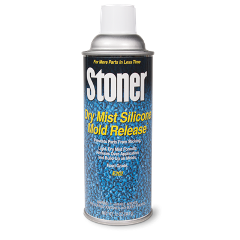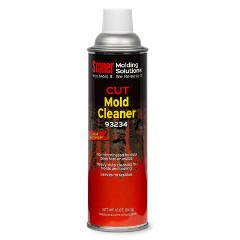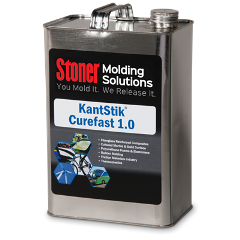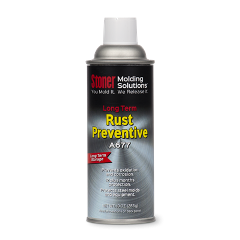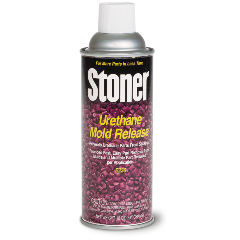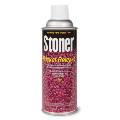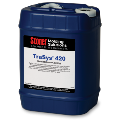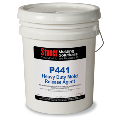Thermoplastics
Enhance Your Plastic Molding Process with Quality Products
When molding plastic materials, you need the finished product to release quickly with minimal molding defects and a consistent finish. However, when inferior mold releases cause parts to stick to the molding surface or impact the product's dimensional
stability, you waste time and money by having to scrap the parts and mold them again. Your thermoplastic and thermoset molding operations deserve better products.
Every molder wants to get as many releases as possible from each application—with less downtime and waste. That's why we at Stoner Molding Solutions have been creating molding solutions for the thermoplastics industry since the 1950s. We work closely with the Plastics industry to create ground-breaking products that reduce scrap and increase productivity.
How Our Plastic Molding Products Benefit Your Production Process
Why would you spend your money on a product that doesn’t directly improve your process? The bottom line is that you want to spend less while producing more. Our high-performing mold release agents for plastic molding, along with our mold cleaners, rust preventatives, mold sealers, and mold lubricants, are specifically formulated and Engineered for the thermoplastics and thermoset industries. Your plastic molding production line can enjoy the benefits of :
- Optimized cycle time
- A consistent surface finish
- Reduce or eliminate post-mold prep work before gluing, painting, metallizing, or welding
- Minimized mold flow lines
- Reduced scrap parts and lower production costs
Want to Try a Sample Before Your Purchase?
We know that you may be a bit skeptical about trying a new product to improve the productivity of your thermoplastic molding operations. But we are also a global leader in molding releases, flow promoters, mold cleaners, and other mold maintenance
products. Just like dozens of other molding companies, you will receive massive benefits for your plastic molding process if you use these products.
These products will improve your final creation and increase both productivity and profits. We are so confident about the products that we would like to offer you a free sample upon request to prove how incredible our products are! Give us a call and we will help you find the right product that will provide the best outcomes, and send you a free sample to prove it!
Industries Worldwide Rely on Our Release Agents
No matter what type of thermoplastic molding you do, we have a molding product for it! From mold releases with silicone and non-silicone formulations that provide an easy release to lubricants that reduce friction and make molding easier, you can count on Stoner Molding for several molding processes.
![]()
Electronics
Electronic cases, components, and cables all use thermoplastic’s incredible durability and insulation qualities for their best results.
![]()
Transport
Durability and chemical resistance maximize safety and lifespan for aeronautic, nautical, and automotive parts manufacturing.
![]()
Medical
Medicine products of all kinds can be made with thermoplastic molding, from pill bottles to heavy-duty x-ray equipment.
![]()
Food and Drink
Food and beverage industries rely upon thermoplastics for a massive array of storage, handling, production, and packaging purposes.
![]()
Construction
The construction industry makes frequent use of molded plastic goods in order to provide you with longer-lasting and safer homes.
Injection Molding
The thermoplastic injection molding process is ideal for high-volume, mass-produced products requiring thousands or even millions of parts, such as toys, kitchen utensils, medical devices, surgical equipment, bottle caps, and more. It is typically a cost-efficient, high-output, low-waste, and versatile endeavor. Challenges can come when thermoplastic injection molding machinery breaks down from excessive wear and tear. Our products help avoid these costly repairs and the downtime that will harm your bottom line. These challenges are why it's crucial to maximize mold performance with Stoner mold products.
Rotational Molding
Combining high temperatures and rotational movement, rotational molding can easily form an even-walled thermoplastic or thermoset component. Some products formed through rotational molding include Kayaks, coolers, bins, tanks, containers, road
cones, and more. Rotational molding produces high-strength parts with very little waste, though it is a slower process than some other plastic molding operations. Choosing a mold release agent for plastic that keeps rotational molding operations moving
efficiently is the key to success.
Extrusion Molding
While other plastic molding processes moves plastic into a mold, extrusion moves melted plastic directly through a die. The die's shape determines the resulting part's shape. This fact makes extrusion perfect for creating atypical
cross-sections and guarantees a smooth finish on the end product. Preventing waste in extrusion molding is essential, and the right mold release agent, sealer, cleaner, and lubricant for plastic molding is central to that goal. Additionally, our coating
products provide easier de-nesting of thermoformed parts which create internal cavities for extruded plastics.
Blow Molding & Packaging
Blow molding, designed for high-volume manufacturing of hollow objects, creates uniformly thin-walled products at a very low cost. It can be used to achieve shapes that injection molding can't support, but blow molding does require close tolerances where build-up on molds can interfere with, increasing waste. You owe it to your team to optimize your blow molds with Stoner mold release agents and our other related products that are designed to reduce build-up and lubricant close points.
Thermosets and Thermoplastics: The Plastic Molding Families
The plastics molding industry can largely be divided into two types of molding: Thermosets and thermoplastics. These two families of plastic molding provide unique benefits and drawbacks to the created products. When you begin your journey towards scaling production, consider what category of plastic will best fit your production needs:
Thermoset
Thermoset plastic molding typically involves injecting a mixture of materials into a high-heat mold. This heat activates a catalyst that forms a permanent chemical bond. This type of molded part typically can’t be reshaped or recycled due to the chemical process, but the result is a heat-resistant and very durable item.
Thermoset materials include:
- Epoxy
- Polyester
- Bakelite®
- Polyurethane
While these products can be very strong and durable, the byproducts of the chemical reaction are Volatile Organic Compounds or ‘VOCs.’ Dealing with these byproducts is a unique challenge for molding at scale. However, less heat and pressure is required.
Thermoplastic
Thermoplastics are, in some ways, a simpler molding material. The base materials are melted down and injected into a cold mold. This is a 100% reversible and renewable process for most thermoplastics. Thermoplastic molding produces more flexible bodies and aesthetically pleasing surfaces on molded objects.
Thermoplastics include:
- Nylon
- Polycarbonate
- Acrylic
- ABS
Thermoplastic requires high heat and high pressure, which means the machinery involved can often require a higher initial investment than other processes. Additionally, the low heat-tolerance can restrict the reasonable uses for the produced goods.
Our molding products can help you maximize your plastic molding production. Thermoplastic and Thermoset molding products can present unique challenges in demolding, cleaning, and sealing. If you are a plastic molding company looking to expand your repertoire or create at a larger scale, come to the molding products company that knows how to enhance and build upon your process.
Why Choose Mold Release Products from Stoner Molding Solutions?
You want an efficient thermoplastic molding process with less waste and downtime. To do that, you need high-quality molding products that help improve your processes. The problem is that so many inferior products that are on the market can cause you to work more and create defective parts, making you feel frustrated.
When you work with us, you receive customized service and product experience that prioritizes cost-effective products that are tailored to your manufacturing process. We understand your molding problems, which is why we have spent the last 80 years Engineering
and designing products to relieve the specific issues you face. Here’s how we do it:
Here’s how we do it:
- Talk to us about your molding frustrations—Tell us what problems you face and what specifications you have for the products you use.
- Try a free sample—We’ll send you a free sample of a recommended product so you can see if it addresses your molding challenges.
- Buy the products of your choosing—When you are convinced that our products are right for you, buy a full-size option on our website or by calling our customer service team at 1-800-227-5538.
So, get started by talking to an expert at Stoner Molding today! And in the meantime, feel free to browse our complete product listings in our plastic molding catalog.
Talk to a Plastic Molding Product Expert Today!
When you need products that can help your thermoplastic molding process run more efficiently, turn to the experts at Stoner Molding Solutions! We have various formulations that are right for your molding operations—whether you do thermoplastic injection molding, rotational molding, extrusion, or blow molding. With more than 80 years of experience, we have the products you need!
Our industry-leading experts, chemists, and engineers are here to listen and provide honest value to your business. We'll help you troubleshoot your process and recommend the right products for your needs. We can even work with you to create custom formulations tailored to meet your production requirements. All you have to do is reach out!
Some of Our Top Selling Release Agents for Plastics
Looking for more information on our top-selling mold releases? Check out these popular options! Don’t hesitate to reach out to us and explain your manufacturing process so that we can give you a product that will exactly match your needs.
Get More Information About Plastic Molding on Our Blog
The thermoplastic and thermoset molding industry is full of intricate specialties and unique molding procedures. Learn more about how to optimize your process, choose the right products, and mold more parts in less time with the experts at Stoner Molding Solutions.
Which Common Products Are Made by the Compression Molding Process?
 If you’ve ever driven in a car or used a plastic utensil to cook food in the kitchen, then you likely have used compression molded parts. Compression molding takes a raw material and uses an appropriate heating technique and pressure to create a molded part. It’s best for parts with complex geometries but few details.
If you’ve ever driven in a car or used a plastic utensil to cook food in the kitchen, then you likely have used compression molded parts. Compression molding takes a raw material and uses an appropriate heating technique and pressure to create a molded part. It’s best for parts with complex geometries but few details.
If you are considering adding this type of molding to your industrial molding operations, there are some things you need to know. Various products made from compression molding make it a lucrative addition to your operations, and the tooling is relatively low cost compared to other molding techniques. However, it’s not as efficient as other types of molding. Read on to explore this molding method and, as always, get expert advice from our mold release experts on the best products to choose for your operations.
What Is Compression Molding?
Compression molding is an industrial molding process that uses heat and pressure. A measured amount of molding material that is generally preheated is usually referred to as a charge. The charge is placed into a heated mold cavity, and another mold compresses it to form the desired shape.
Compression molding is sometimes compared to thermoplastic injection molding. In this process, the charge is injected into a closed mold. After, it goes through a curing process to harden into the desired shape. When considering compression molding vs. injection molding, compression typically has lower tooling costs, but injection molding is better suited for high-volume production.
Compression molding was developed for synthetic materials and is the least expensive molding method for thermosetting plastics. There are four types of compression molds: flash, landed positive, positive, and semi-positive-type molds.
How Does the Compression Molding Process Work?
Products made from compression molding typically follow four primary steps, from raw material to a completed composite component. While each compression molding manufacturing process is unique and may include customized steps in between or after these four steps, the following process will give you a good indication of the basics of this molding method.
1. Setting up the Machine
First, the machine needs to be cleaned using the right mold cleaners for the type of molding being done. Then the mold cavity’s surface must be prepped with a mold release to ensure the part releases quickly and easily after the molding process is completed. The compressing molding machines are then turned on to begin preheating, and then the process parameters are set for the correct molding technique.
2. Preparing and Inserting the Charge
Next, mold operators will prepare the charge. First, the proper amount of charge is measured because excess material will seep out of the machine, resulting in a flash that you must cut off manually. Usually, the charge is then preheated using a specified heating technique for the molding project. Then it’s placed in the center of the bottom half of the heated molds.
3. Compressing the Material
The third step is compressing the mold. An operator will close the top heated cavity onto the bottom half and apply pressure. Sometimes more heat is added at this stage to soften the raw materials and make molding quicker. This compression forces the material to fill the entirety of the mold cavity to ensure the desired density of the product and accelerate curing.
4. Releasing the Part
The part is then released from the molding machine, sometimes with the help of ejector pins. The molding technician will also finish the part by removing excess resin flash around the edges and cleaning up the part before heading to secondary processes or final assembly.
What Products Are Made from Compression Molding?
Because the compression molding process is cost-effective, produces strong parts, and has design flexibility, many industries turn to it for various parts. Some of the products made from compression molding include:
- Automotive Industry
- Large automotive parts, like fenders
- Car panels
- Engine components
- Interior automotive components
- Technology
- Video game controllers
- Keyboards
- Mouse
- Joystick covers
- Household
- Kitchen tools
- Utensils
- Appliances
- Bowls, cups, plates
- Mirror handles
- Electrical Components
- Electrical sockets
- Switches
- Faceplates
- Metering devices
- Medical
- Syringe stoppers
- Respirator masks
- Rubber clothing
What Materials Are Used to Create These Products?
With so many different products made from compression molding, various types of composite resins and plastic materials are used in the process. Some of these include:
- Bulk molding compound (BMC – a mixture of resins, chopped fibers, and a hardening agent, resulting in a pliable material similar to sheet molding compound)
- Carbon fiber (can make a more rigid composite material)
- Diallyl phthalate (DAP)
- Epoxy resin
- Glass fibers (can be added to resins to form composite materials to make stronger parts, such as sheet molding compounds)
- High-density polyethylene (HDPE – Can be mixed with natural rubber to make composite parts)
- Melamine
- Nylon
- Polyamide-imides (PAIs)
- Polyether ether ketone (PEEK – can be used to replace metals in certain applications)
- Polyurethane (PU)
- Polyphenylene sulfide (PPS)
- Phenolic molding compound (thermoset plastics, which have high temperature-resistant properties and dimensional stability)
- Polytetrafluoroethylene (PTFE – has a very high viscosity and good non-stick properties)
- Sheet molding compounds (SMC – typically consists of two layers of polymer resin with a layer of glass fibers in between)
- Silicone rubber Urea-formaldehyde (UF)
How Can You Make the Compression Molding Process Easier?
Using a release agent to cure the mold before the molding process begins makes compression molding processes easier. Various types of mold release are available, and the best ones on the market are the ones we make.
When choosing the best mold release agent for your product, considering factors such as the type of polymer you are molding, whether it requires post-cure, and the maximum temperature required for operation can help you make an informed decision. We specialize in guiding molding professionals to the right product for their needs, and offering a range of sacrificial and semi-permanent products tailored to epoxy, phenolic, polyester, vinyl ester, and polyurethane systems. Our specialized products can help reduce sticking parts and wasted time in production processes while producing superior parts with less waste.
Get Customized Support for Your Compression Molding Operation
Compression molding is an industrial molding process used to create various products, from automotive parts to household items. The process involves several steps, including preparing the charge, compressing the material, and releasing the part. This type of molding is cost-effective, produces substantial parts, and offers design flexibility, making it a popular choice among many industries.
Whether you’re looking to start manufacturing some of the many products made from compression molding or need to improve your existing operations, we can help! Talk to one of our experts to learn more about compression molding and how we could help your business succeed.
Resources:

